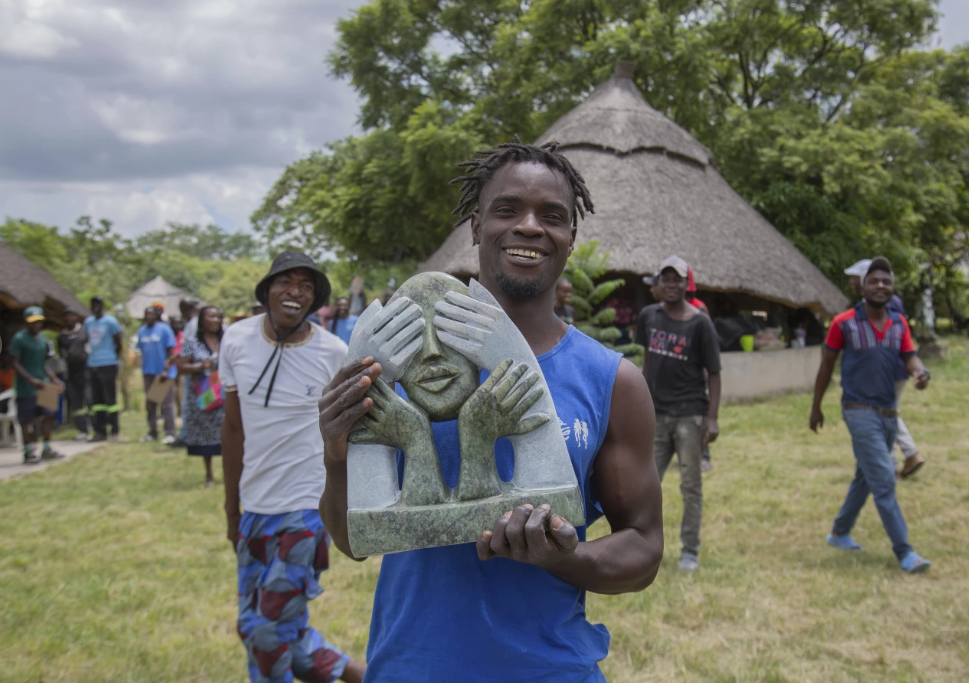A striking collection of stone sculptures from Zimbabwe is set to take center stage at an upcoming exhibition at Oxford University, boldly confronting the legacy of British imperialist Cecil John Rhodes. The pieces explore themes of religious manipulation, forced labor, and sexual violence under colonial rule.
One sculpture shows white hands covering the eyes of a Black face. Another features a grinning colonizer with a Bible crushing a screaming native’s skull beneath his boot. There are depictions of chained men toiling in gold mines and a pregnant woman—haunting images that give voice to a painful history.
This exhibition, taking place at Oxford’s Oriel College in September, carries deep symbolic weight. The college is home to a statue of Rhodes, whose presence has sparked protests since 2015. Rhodes, an Oriel alumnus, amassed wealth through mining and land seizures across southern Africa in the late 19th century. He left a large donation to the college and remains a controversial figure, his influence lingering through scholarships still awarded in his name.
For the artists at Zimbabwe’s Chitungwiza Arts Center near Harare, the exhibition is more than just historical commentary—it’s a rare opportunity to share their craft with a global audience and breathe new life into a struggling art form. Stone carving, once a vibrant local industry, has suffered in recent years due to economic hardship and a drop in tourism.
Wallace Mkanka, one of the participating artists, created the sculpture of the blinded Black face, which was selected as the best among 110 entries. He hopes the show will open doors for international recognition and direct sales. “Buyers abroad will now see our work and buy directly from the artists,” he said.
Zimbabwe, whose name means “House of Stone,” takes pride in its legacy of stone artistry. The tradition dates back to the Great Zimbabwe ruins, a massive 1,800-acre Iron Age city known for its mortarless stone architecture and recognized as a UNESCO World Heritage Site. Despite efforts by colonial rulers to suppress local customs, stone carving endured and later thrived on the global stage.
Thousands of sculptures were taken from Africa during colonial times—some have been the focus of repatriation campaigns, while others are cherished in collections worldwide. A permanent display of 20 Zimbabwean stone pieces, for example, can be found in a pedestrian tunnel at Hartsfield-Jackson Atlanta International Airport.
After Zimbabwe gained independence, the stone sculpture market boomed. Many white farmers purchased artworks for their homes and helped artists access international buyers. Sculptor Tafadzwa Tandi remembers a time when clients were abundant and paid in advance for his work. His piece will also be featured in the Oxford exhibition.
However, things changed dramatically after the controversial land reforms of the early 2000s, which displaced over 4,000 white farmers in a bid to address colonial-era inequalities. While the reforms redistributed land to hundreds of thousands of Black families, they also disrupted the art market.
“Many of our customers were friends of the farmers,” said Tendai Gwaravaza, chairman of the Chitungwiza Arts Center. “That is where the problem originated from.” Now, with fewer buyers at home, the artists believe the solution is to engage directly with global markets.
The Oxford exhibition is a promising step in that direction. It was organized by the Oxford Zimbabwe Arts Partnership (OZAP), which includes Zimbabwean sculptors, a former Oxford student, and a professor of African history. The group was inspired by the “Rhodes Must Fall” movement and initially proposed a much larger project called Oxford and Rhodes: Past, Present, and Future.
That original plan envisioned enclosing Rhodes’ statue in glass, installing 100 life-sized bronze figures of African liberation fighters, and creating a sculpture from recycled materials symbolizing the continent’s future. But with an estimated cost of 200,000 pounds, the ambitious vision had to be scaled back. Oriel College eventually contributed 10,000 pounds to support a smaller exhibition.
Richard Pantlin, the Oxford alumnus who co-founded OZAP, still hopes the larger project might one day come to life. “For now, we’ve accepted something very small to make a start and to do something,” he said.
For the artists of Zimbabwe, even this modest step is a meaningful one—an opportunity to reclaim their history, showcase their resilience, and share their stories through stone.













